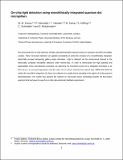On-chip light detection using monolithically integrated quantum dot micropillars
Date
22/02/2016Metadata
Show full item recordAbstract
We demonstrate the on-chip detection of light using photosensitive detectors based on quantum dot (QD) micropillar cavities. These microscale detectors are applied exemplarily to probe the emission of a monolithically integrated, electrically pumped whispering gallery mode microlaser. Light is detected via the photocurrent induced in the electrically contacted micropillar detectors under reverse-bias. In order to demonstrate the high potential and applicability of the microdetector presented, we determine the threshold current of an integrated microlaser to be (54 ± 4) μA, in very good agreement with the value of (53 ± 4) μA inferred from optical data. Within this work we realize the monolithic integration of a laser and a detector in a single device operating in the regime of cavity-quantum electrodynamics. Our results thus advance the research on microscale sensor technology towards the few-photon quantum limit and pave the way for on-chip opto-electronic feedback experiments.
Citation
Karow , M M , Munnelly , P , Heindel , T , Kamp , M , Höfling , S , Schneider , C & Reitzenstein , S 2016 , ' On-chip light detection using monolithically integrated quantum dot micropillars ' , Applied Physics Letters , vol. 108 , no. 8 , 081110 . https://doi.org/10.1063/1.4942650
Publication
Applied Physics Letters
Status
Peer reviewed
ISSN
0003-6951Type
Journal article
Description
This work was supported by the German Research Foundation (DFG) under Grants RE2974/9-1 and SCHN1376/1-1. The research leading to these results has received funding from the European Research Council under the European Union's Seventh Framework ERC Grant Agreement No. 615613.Collections
Items in the St Andrews Research Repository are protected by copyright, with all rights reserved, unless otherwise indicated.

